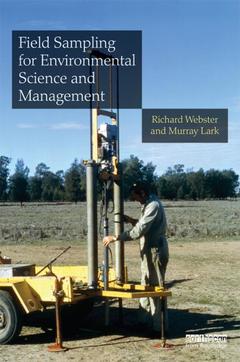Field Sampling for Environmental Science and Management
Auteurs : Webster Richard, Lark Murray

Scientists and consultants need to estimate and map properties of the terrestrial environment. These include plant nutrients and parasites in soil, gaseous emissions from soil, pollutant metals and xenobiotics in waste and contaminated land, salt in groundwater and species abundances above ground. The scale varies from small experimental plots to catchments, and the land may be enclosed in fields or be open grassland, forest or desert. Those who sample the variables to obtain the necessary data need guidance on the design and analysis of sampling methods for their conclusions and recommendations to be valid.
This book provides that guidance, backed by sound rationale and statistical theory. It concentrates on design-based sampling for estimates of mean values of environmental properties, emphasizing replication and randomization. It starts with simple random sampling and then progresses to more efficient designs, such as spatially stratified random sampling, stratification by classes and cluster sampling. It includes a section on purposive sampling in classical soil survey, which is relevant to other environmental properties such as vegetation. It also describes the effects of bulking on errors and the use of ancillary information and regression to improve estimates. The authors draw the important distinction between design-based sampling for estimating means and model-based methods (geostatistics) for local spatial prediction and mapping, and focus on the latter. They describe designs suitable for computing variograms and prediction by kriging, as well as a staged approach, so that sampling is neither inadequate nor excessive, and designs adapt as knowledge is accumulated. Including numerous worked case studies of sampling in agriculture, ecology and environmental science, the book will be of immediate practical value.
1. Introduction. 2. Aims and Concepts. 3. Simple Random Sampling. 4. Efficiency, Economy and Logistics. 5. Prediction from Spatial Classifications. 6. Sampling from Designed Experiments. 7. Sampling for Regression and Calibration. 8. Nested Sampling and Analysis. 9. Geostatistics - Model-based Prediction
Richard Webster is a Lawes Trust Senior Fellow at Rothamsted Research, Harpenden, UK, and former Editor-in-Chief of the European Journal of Soil Science. He is author of one book and co-author of two others on applied statistics.
Murray Lark is an Environmental Statistician at the British Geological Survey, Nottingham, UK.
Date de parution : 07-2012
Ouvrage de 192 p.
15.6x23.4 cm
Date de parution : 07-2012
Ouvrage de 192 p.
15.6x23.4 cm
Disponible chez l'éditeur (délai d'approvisionnement : 15 jours).
Prix indicatif 160,25 €
Ajouter au panierThèmes de Field Sampling for Environmental Science and Management :
Mots-clés :
Soil Science; Statistics; Environmental Science; Environment and Sustainability; Biodiversity and Conservation; Environmental Impact Assessment; Statistical Theory; Sampling; Natural Resource Management; Soil Scientist; La Chaux De Fonds; Ranked Set Sampling; Maximum Lag Distance; Soil Survey; Simple Random Sampling; Kriging Variance; REML Estimator; Non-irrigated Soil; REML Estimate; Nested Sampling; Variogram Parameters; Prediction Error Variance; Unaligned Sampling; Minimum Detectable Difference; Received Mineral Fertilizers; Lag Distance; Punctual Kriging; Unit Topology; Wyre Forest; Kriging System; Simulated Annealing; Unbalanced Nested Design; Confidence Region; Sampling Nematodes



